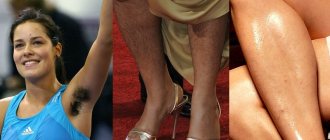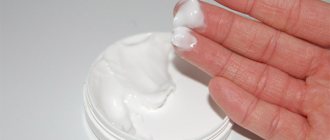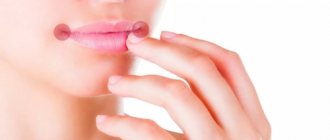The process of peeling off the top layer of keratinized skin occurs constantly, due to the renewal of the epidermis. Excessive accumulation of “scales” on the skin of an animal is called dandruff. Dandruff is a symptom of a pathological condition caused by disruption of the sebaceous glands and characterized by an increase in the rate of detachment of skin particles in the form of scales over a long period of time. The scientific name of this disease is seborrhea. It affects kittens and adult cats of all breeds, regardless of gender.
In the article we will tell you why dandruff appears, what to do when it is detected, how to cure seborrhea by going to the doctor and at home, as well as possible complications of the disease and preventive measures.
Main features
Signs of seborrhea in a cat:
- excessively oily skin under the coat;
- excessive amount of white “scales” of keratinized skin;
- inflammation (redness) of the skin;
- presence of itching.
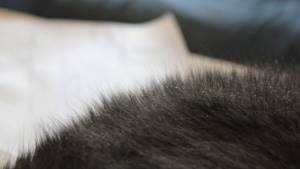
There are three types of seborrhea:
- dry: “scales” of skin fall off when stroking the fur;
- oily: dandruff does not fall off when combed, the “scales” are glued together;
- mixed type.
Causes of dandruff
There are external and internal causes of the disease.
External ones include:
- Low level of air humidity. Dry air negatively affects the skin of the animal, the skin becomes thick and dry, and dandruff appears. Often accompanied by the appearance of cracks on the paw pads.
- Lack of proper care for the cat's fur and its place of residence, unsanitary conditions. In this regard, fleas, lice and other parasites appear and actively reproduce, causing irritation and itching of the skin. Dandruff can be caused by mites if the animal walks outside.
- The effects of cosmetics and cleaning products on animal fur.
Important! Using shampoo intended for humans may cause allergic reactions on your pet's skin.
- Improper combing of fur. Leads to irritation, scratches and microtraumas of the animal’s skin, which leads to accelerated skin regeneration and the appearance of “scales”.
- Sunburn or excess ultraviolet rays. They lead to accelerated death of epidermal cells and, accordingly, the appearance of dandruff.
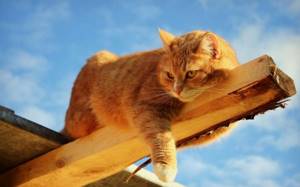
- Stressful situations. For example: sterilization, moving to a new place, bringing another pet or child into the house.
- Frequent contact with water. Constant wetting of the skin causes irritation and drying out of the upper layer of the epidermis.
Internal factors:
- Incorrectly formulated diet. It entails a lot of health problems, such as:
- Obesity. If an animal is overweight, it is difficult to care for itself, reaching the back and lumbar area, which is why excess dandruff accumulates in these places.
- Allergic reactions.
Carefully! Allergies can be caused not only by food, but also by chemicals in finished food.
- Problems with the digestive system. They lead to metabolic disorders in the body, which affects the appearance of the cat.
- Vitamin deficiency or excess vitamins. For example, when there is a lack of vitamins A and B in the body, or when there is an excess of them, seborrhea appears.
- Bacterial or fungal diseases. For example, microsporia or lichen lead to skin irritation, constant itching and hair loss in the affected areas.
- Hormonal disorders (hypothyroidism, sex hormone imbalance, Cushing's syndrome). Disturbed metabolism associated with the functioning of the thyroid gland leads to seborrhea.
- Diseases of the musculoskeletal system (arthritis, arthrosis). Pain in the joints when moving prevents the cat from grooming the rump and tail areas, which leads to excessive deposits of “scales” on the skin in these areas.
- Diabetes. A disease associated with insufficient production of the hormone insulin and leading to metabolic disorders, which also affects the animal’s skin.
- Diseases of the urinary system.
- Seborrhea of idiopathic form. This is a hereditary disease characterized by the active secretion of sebum.
- Side effect from drug treatment. Skin reactions occur to medicated shampoo or to taking medications.
List of possible causes
In isolated cases, dandruff appears in a cat without any accompanying symptoms. Almost always its appearance is accompanied by itching, redness of the skin, hair loss and even swelling. All this can cause the following pathologies:
Allergic reaction. The most difficult cause to diagnose. The thing is that it is almost impossible to confirm or exclude allergies. It is even more difficult with an allergen, which can be found by exclusion. Often an allergic reaction is provoked by food that contains incorrectly selected food or foods from the owner’s table (fatty, smoked, sweet, flour, etc.). Food allergies very often plague Persians, Siamese, Maine Coons and Scots. Hypoallergenic foods are excellent for these breeds. It's even more difficult if the allergen is not in the food. This could include dust, hair from other pets, tobacco smoke, or detergents. All of the above can cause dandruff, redness, hair loss and severe itching in a cat. After scratching, white, mucoid scales will remain in the place where the pet was sitting. Redness of the skin appears under the fur; in severe cases, large bald patches and weeping wounds appear. Very often complicated by secondary infection. You need to understand that in the future, your animal will face lifelong treatment during exacerbations, which will be based on the effective selection of antihistamines and minimizing contact with potential allergens. Lichen. The second most common cause of white dandruff in cats' fur. Contrary to numerous misconceptions, it is not only homeless animals that suffer from deprivation. In pets, it occurs, of course, less frequently, but it usually occurs in an aggressive form and is dangerous for all residents of the house. A distinctive feature is the appearance on the body (stomach, limbs, muzzle) of small bald patches or wet areas of fur
You can notice how the cat begins to pay special attention to this place (licking, combing or gnawing if it gets it). As the process progresses, the affected area may increase to the size of a saucer or spread to other areas of the body.
To make a diagnosis, a scraping must be taken from problem areas for microscopic examination. These areas are also illuminated under a Wood's lamp. In difficult situations, fungi taken from the affected areas are inoculated to determine the culture. Long-term treatment with the use of antifungal drugs in the form of ointments and tablets. Shampoos also get good reviews. Particular attention is paid to disinfection, the quality of which will determine whether someone else in the house gets sick and whether the sick animal has a relapse. To avoid this, all objects that an infected pet comes into contact with must be treated with steam (sheets, rugs, carpets, chairs, sofas) and a chlorhexidine solution (furniture, can also be added to water when washing the floor). Cheyletiellosis. A parasitic disease that most often affects young individuals. You can find a huge amount of dandruff in the fur, which is easily shaken off when stroking the cat. You can become infected through someone else's bedding or close contact with a sick animal. Much attention is paid to immunity if cheyletiellosis is detected in adults. Long-term use of antibiotics or tumor processes can provoke mite activity. Fleas. Another common cause of black dandruff in cats of all breeds. There are owners who believe that since their pet does not come into contact with other animals and does not go outside, then there is no way for him to pick up fleas. A big misconception, since usually these same owners are the source of infection for their cat. They can be brought from the street on shoes or clothes. Only timely and regular treatment of all animals living in the same house against fleas with medications (Advantage, Stronghold, Frontline or Lawyer) can help here. It is believed that treatment once every 3 months will be good prevention against fleas and ticks.
Types of dandruff
Dandruff is distinguished by color and location:
- By color:
- Yellow-white (grains or flakes) is localized on the back and other areas due to allergies, sunburn or malfunction of internal organs.
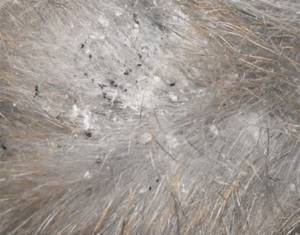
Black impurities in dandruff
- Black flecks in the fur along with dandruff can be a sign of fungal infections or the presence of parasites.
- By localization:
Cat's diet for dandruff
If dandruff appears on a cat’s back or hair falls out, the first thing the owner can do is to reconsider its diet. Dandruff may indicate liver problems. Ready-made inexpensive food that an animal eats can lead to this result, as it contains chemical additives and preservatives that have a bad effect on the animal’s body.
Before purchasing food, the owner needs to carefully study its composition. It is better to give preference to expensive foods that contain natural products, vitamins, and minerals.
The animal's diet should be filled with vitamins A and B. These, along with fatty amino acids that are beneficial for the skin and coat, can be purchased at a veterinary pharmacy.
How to prevent seborrhea
Try to help your pet get rid of the disease yourself using the following methods:
- carry out antiparasitic treatment at home;
- check the air humidity level, you may need a humidifier;
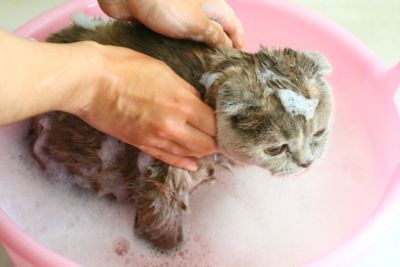
Bathing a cat to treat dandruff
Important! If after carrying out all the above measures the disease progresses, contact your veterinarian.
Prepare in advance the answers to the questions that the doctor will ask you at the appointment to make the correct diagnosis. List of sample questions:
- What is the cat’s diet (main products, diet, amount of food).
- Basic habits and behavioral characteristics of the pet (for example, does it like to lie in the sun, which can cause sunburn).
- How well are hygiene rules observed at home?
- What products and how often do you use when bathing your pet and cleaning the house?
- What vitamin supplements do you give?
- Where and in what conditions does the cat live?
- What was or is you sick with? What medications were used for treatment.
- How do you care for your fur?
After collecting anamnesis, the doctor will prescribe the following tests:
- general blood test and biochemistry;
- blood test for hormones;
- skin scraping;
- inoculation on a nutrient medium and identification of skin culture;
- skin biopsy.
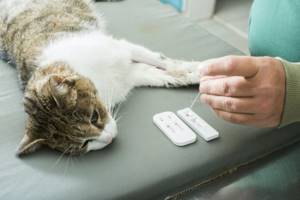
LiveInternetLiveInternet
Then the doctor will conduct tests to determine the quality of seborrhea (see above) and the following tests: general blood test; blood biochemistry; hormone analysis; skin scrapings and skin cytology; culture on a nutrient medium and identification of a skin culture (to identify a bacterial or fungal pathogen); skin biopsy. If the tests do not reveal a chronic disease, then treatment will consist of changing the menu and changing cosmetic products. Sweet foods and fatty foods should disappear from the cat's menu, and foods containing vitamins of group A should appear. And a special anti-dandruff shampoo for cats will normalize the functioning of the sebaceous glands, perform an antifungal and antibacterial function, and exfoliate dead skin cells.
What to do if you find dandruff on your cat? If you are not sure of its causes, if you suspect serious underlying causes, the advice of a veterinarian who knows how to remove dandruff from a cat will help you. To begin with, the veterinarian takes an anamnesis: the animal’s activity, past illnesses, what cosmetics are used to bathe the cat, the names of antiparasitic drugs, and so on.
Dandruff in a cat According to legend, a cat has 9 lives and what a shame if the animal lives one of them suffering from dandruff. Yes, dandruff occurs not only on the heads and not only on people, but also on the tails, backs and paws of cats. Moreover, seborrhea can appear like in a British cat. so does the charming mongrel beauty. Dandruff is the top scaly layer of the skin, which flakes off too quickly as a result of its necrosis.
If the dandruff is showered with “fine flour” and is easily separated from the skin, then it is dry dandruff. Its treatment regimen is different from the treatment regimen for oily dandruff. Signs of oily seborrhea are glued hairs on the back and behind the ears, and the greasy quality of the coat in general. A slight “snowfall” movement of the hand cannot lift such scales; they remain under the nails when the animal is scratched. By the way, you should not expect that the color of the dandruff matches the color of the cat.
First, let's figure out what factors influence the formation of dandruff. Conventionally, these factors can be divided into external and internal. External causes of dandruff in cats Dry indoor air
Health to you and your pet!
The body simply rejects dead skin cells, which is how visible “snowflakes” appear. Is it necessary to fight dandruff in cats? It's a no-brainer! Dandruff in a cat is the cause of many troubles that befall both the animal and its owner. Causes of dandruff in cats
Finish bathing your animal by rinsing the fur and skin with this decoction and the problem will go away faster. And don't forget about grooming. Daily brushing of a cat stimulates the fur to grow stronger by massaging the skin and improving blood circulation underneath it. Prevention of dandruff in cats Humidify the air in the room where the cat lives (especially during the dry period) and provide it with constant access to water;
Gastrointestinal diseases Diseases of the genitourinary system Hormonal imbalances
Treatment at home NOTE TO THE OWNER! A decoction of burdock root, calendula, and nettle is a good remedy that helps in the fight against seborrhea.
Diseases of internal organs Problems with the thyroid gland or diabetes mellitus provoke the appearance of dandruff Allergies
Classically, dandruff flakes are yellow, white or gray. Black dandruff indicates the presence of fungi, parasites or acne. We comb out the dandruff-laden fur using a furminator. Read how to choose the best furminator. Treatment of dandruff in cats
Fleas and ticks affect the appearance of seborrhea. Among the fungi we can distinguish: microsporia (affected area - hair on the back, skin, claws) ringworm (affected area - hair on the face, near the tail) Excessive solar ultraviolet radiation accelerates the death of skin cells, as a result - dandruff on the cat’s back. Internal causes of dandruff in cats
With a lack of moisture in the air, the animal's skin becomes denser and rougher. And seborrhea is the first reaction to the lack of proper hydration. Fungi or parasites If the cat is insufficiently or poorly cared for, the fur becomes a breeding ground for parasites.
Make sure that the cat does not stay in the open sun for too long; Prevent possible stress in advance with sedatives; Monitor your pet's diet and weight.
Mainly due to the fact that an overweight animal is not able to properly care for itself in hard-to-reach places. Separately, we note that the above reasons influence the fact that the quality of dandruff is different. It can be dry or oily. You can determine this by stroking the cat against the grain.
Choose a high-quality shampoo for bathing; Don't bathe cats in hot water; Prevent parasites from appearing in your fur;
Dull fur and flaky skin are some of the signs of food or environmental allergies. Stress Cats react very sharply and emotionally to stressful situations.
The same effect is possible from the use of certain shampoos. There is dandruff - there are no fatty acids (omega-3 and omega-6) in the bowl and there is a reason to reconsider the cat’s diet. Does your cat still have hair coming out? The lack of essential fatty acids is a proven fact. In overweight cats, dandruff often forms on the back near the tail.
YOU CAN ORDER ON THE OFFICIAL WEBSITE
It would seem that just a short trip - and the cat’s hair is already falling out, seborrhea, fears and phobias have appeared. Taking medications Dandruff in a cat during drug therapy can be a side effect, as some drugs cause dry skin.
Treatment of seborrhea
Treatment of seborrhea is prescribed comprehensively, it includes:
- prescription of medications;
- changing the diet and composition of food;
- prescription of vitamins (Sherstevit, Phytomins VEDA, Farmavit NEO, Beaphar and others) and food additives containing Omega-3 fatty acids;
- prescribing a course of antifungal therapy and antibiotics for fungal and bacterial infections, as well as retinoids;
- improving the sanitary condition of the room where the cat lives;
- changing the care of the animal's fur;
- use of medicated shampoos;
- use of folk remedies;
- skin massage and proper combing of the coat.
Carefully! At home, treatment of seborrhea can be carried out after consulting a doctor, prescribing special detergents and permission to use traditional medicine.
Effective shampoos for seborrhea include:
- Antifungal and antiseborrheic: “Doctor”, “Veterinary Formula Clinical Care”, “Tea Tree”, SynergyLabs Veterinary Formula Antiseptic & Antifungal, Anju Beauté.
- For fleas and parasites: “Clandestine”, “Bayer Adventage 80”, “Beaphar”, “Fiprex”.
- For ectoparasites: "Lufenuron Oral Suspension For Cats".
- To normalize the functioning of the sebaceous glands: “Biovax”
Complications
Complications of seborrhea may be the following:
- Purulent dermatitis. Occurs in the area affected by seborrhea due to the layering of bacterial flora, usually located on the upper layer of the epithelium and does not cause reactions. Ulcerations form, itching intensifies, and the skin becomes very red.
- Eczema. Redness and itching of the affected area after scratching becomes covered with papules (nodules), in place of which vesicles (bubbles) with liquid appear. Pyogenic bacteria enter places with opened blisters, the wounds become infected and ulcers, ulcers and erosions appear. The skin is constantly inflamed, swollen, raw, and the animal is in pain.
Prevention
Disease prevention measures include:
- Ventilate the room and provide sufficient air humidification.
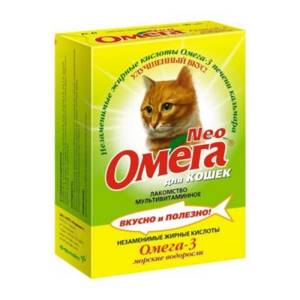
Omega-3 fats to prevent dandruff
To avoid serious consequences for your pet’s health, carefully monitor its condition and lifestyle, provide proper care and optimal living conditions, and do not neglect contacting an experienced veterinarian at the slightest sign of illness.
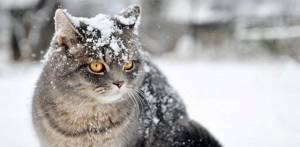
The formation of seborrhea, or dandruff, in cats is not so much an annoying external defect in the coat, but rather a serious signal that not everything is in order in the animal’s body. To get rid of pathology, you will need to identify the cause, and then carry out a whole range of measures in different directions. In addition, the owner must be patient and knowledgeable about the characteristics of this disease.
Preventive measures
You can eliminate the risk of unpleasant consequences for your pet. What do you need to do for this?
- Nutrition control : a balanced and varied diet, including fresh foods (vegetables, meat, cereals).
- Regular water procedures : it is necessary to wash your cat, but you should not overuse detergents.
- Controlling humidity in the house: wet cleaning, lack of dust and maintaining cleanliness are an excellent prevention of cat dandruff and hair loss.
- Regular examination by a veterinarian to assess the health of the cat. When the first signs of seborrhea appear in a cat or cat, when the coat becomes oily and unhealthy, timely help is required.
Taking care of the health of your furry pet is a big responsibility for all family members. A defenseless animal cannot help itself, and the main role is given to the owners. Solving a problem is much easier if it is detected in time. Proper treatment will make life easier for a cat or cat and improve their well-being.
We recommend reading: Mezim For Dogs
If there are parasitic or fungal diseases, the doctor will prescribe the necessary treatment. Treatment is prescribed similarly for other pathologies of the pet. In case of allergic reactions, cats and kittens are prescribed antihistamines and the source of irritation is excluded.
What type of dandruff does cats have?
There are 3 types of dandruff in felines.
- Dry. It can be shaken off your hands and fur. Gives the animal's hair a dry, dull appearance.
- Fat. May have different thickness. Thus, the “liquid” version is manifested by a pronounced greasiness of the hairs, which are glued together. If you stroke the animal, excess secretion will remain on the palm. With increased density of dandruff (less sebaceous secretion and more skin flakes), it remains in large quantities under the owner’s nails when trying to scratch the pet.
- Mixed. The death of skin cells and the work of the sebaceous glands occur unevenly on the surface of the animal’s body, which leads to alternating dry and oily seborrhea.
If your pet has dandruff: diagnosis and treatment
If the owner notices dandruff on the cat's back, near the tail, or in other places, he should take it to the veterinarian. The doctor needs to tell about the animal’s diet, living conditions, the moment when the problem appeared, and whether the animal’s hair is falling out. The veterinarian needs to be told everything down to the smallest detail: what medications were given to the pet, what illness he recently had, whether parasites were poisoned, what shampoo is used for bathing. All these little things will enable the doctor to draw up a picture of the disease and suggest how to get rid of dandruff in a cat.
He must also conduct special tests: skin scraping, urine and blood tests (they will help identify hidden diseases).
Having determined that the cat does not have chronic diseases that could cause dandruff, the doctor may advise changing the diet and shampoo. A special diet is not prescribed, but it is better to exclude fatty and sweet foods from the animal’s diet.
The doctor will also recommend anti-dandruff shampoo for cats. Typically, such hygiene products are antibacterial, antimicrobial, clean the animal’s skin well and should restore the functioning of the sebaceous glands.
If a cat has dandruff on its back and the owner is wondering what to do, folk methods can also help. Wool can be rinsed with a decoction of burdock and calendula, sea buckthorn and nettle, or coltsfoot with calamus.
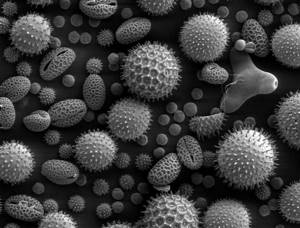
Why does dandruff occur in cats?
The causes of dandruff in cats are divided into two categories: external and internal.
- Poor coat care (insufficient quality combing, infrequent washing, unsanitary living conditions, etc.)
- Dry air (dry skin leads not only to seborrhea, but also cracking of the pads of the limbs)
- Ultraviolet rays (accelerate keratinization processes, dry the skin, disrupt heat exchange processes)
- Incorrectly selected animal coat care products
- Stress
- Microtrauma of the epidermis (for example, due to an incorrectly selected comb)
- Frequent bathing (leads to dry skin)
- Allergies (to food, bedding material, parasites, etc.)
- Overweight cat
- Errors in the diet
- Deficiency or excess of vitamins or minerals in food
- Disturbances in the activity of the endocrine system (diabetes, hypothyroidism and others)
- Digestive diseases
- Infections (bacterial, fungal)
- Heredity (idiopathic variant of pathology caused by genes)
- Side effect from taking medications (external or internal)
Features of the disease and hair loss
The appearance of dandruff in a cat or cat may indicate various health problems. Manifestations can be observed on any part of the animal’s body. But most often, dandruff starts on the back.
The color of dandruff in cats can be completely different, from white dandruff to black. The seriousness of the problem is due to the fact that pets are rarely washed, and purulent pimples may appear, which are a focal point for infections.
Often, male cats develop dandruff in large quantities and hair grows out. Typically, this phenomenon is not a sign of an animal molting, but indicates the presence of any diseases .
Diagnosis of dandruff in cats
To cure a mustachioed pet, you need to find out why he has dandruff. And here you cannot do without the help of a veterinarian. At the clinic, the owner will definitely be asked about the cat’s living and feeding habits, favorite habits (for example, he prefers to “sunbathe” in direct sunlight), hygiene products, previous diseases, and so on.
A mandatory item will be the passing of laboratory tests (which ones - at the discretion of the doctor):
- blood for general indicators, biochemistry, hormonal changes;
- taking material from the surface of the skin;
- biopsy;
- cultural research in a nutrient medium and others.
If tests show pathological changes in the animal's body, the veterinarian may order further examination.
Is it possible to determine the cause of dandruff at home?
In the absence of a veterinarian, you can roughly find out what caused dandruff in your cat. For example, if there are light yellow scales on the pet’s body, then such seborrhea can be caused by allergies, UV radiation (from the sun), or a disorder of the internal organs.
Black dandruff is a sign of an infectious disease caused by parasites or fungus. If this symptom occurs, the owner should immediately take the cat to a veterinarian.
If increased shedding of dead skin particles is localized near the tail, it can be assumed that the pet has received a sunburn or has contracted a fungal infection. The same location of seborrhea is observed in felines that are overweight (since it is physically difficult for the animal to reach this area).
Helminth infections, dermatomycosis, joint diseases and other pathologies can lead to dandruff, localized not only in the tail area, but also in the lumbar area. And wandering dandruff (in the form of “tracks”) on the back, face, and paws is often a sign of a subcutaneous mite.
How to spot dandruff on an animal?
How can the owner distinguish the natural change of the skin from a problem? Very simple. “Snowflakes” become noticeable when stroking the animal. Most often they appear near the tail, but can affect the entire fur of the animal.
The scales themselves may look different and be of different sizes. They come in white, yellowish, and gray colors - it all depends on the pigmentation of the pet. There is even black dandruff, but it signals the presence of parasites in the animal’s body. The scales may feel greasy or dry to the touch. And the size varies from flour grains to flakes.
Why is dandruff dangerous for cats?
Neglected dandruff can lead to complications. One of them is hair loss, up to complete or local baldness. It happens that such places are difficult or impossible to restore in the future. Hair loss occurs due to the fact that dandruff accumulations interfere with gas exchange in the skin, causing disruption of metabolic processes and weakening of hair follicles.
Another complication is purulent inflammation of the skin, reaching the deep layers. The accumulation of dead epidermis serves as an excellent breeding ground for the proliferation of pathogenic microorganisms. Normally, they live on healthy skin, but cannot cause harm due to the good functioning of local immunity. With seborrhea, the immune system weakens, microbes multiply, redness, irritation, and itching occur. As a result of scratching, the infection penetrates even deeper - ulcers, pus, and eczema appear.
Prevention measures
The appearance of dandruff on your cat's fur can be prevented. To do this you will need:
- Brush your pet periodically, especially if it has long hair, and also during shedding;
- prevent the animal from staying in the sun for a long time;
- provide a balanced diet, sufficient amounts of vitamins and minerals;
- when feeding industrial formulations, carefully read the information about the ingredients they contain, avoiding large amounts of allergenic substances (dyes, preservatives, flavors);
- during water procedures, monitor the water temperature, preventing it from increasing;
- buy quality shampoos;
- regularly carry out prevention of internal and external parasites;
- monitor the caloric content of your cat’s food, avoiding excess weight;
- eliminate stress.
When you notice the first symptoms, you must take your cat to a veterinarian. You should not treat dandruff on your own through trial and error.
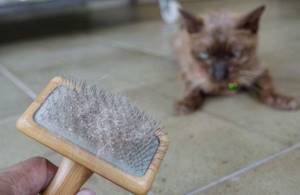
Sometimes the owner, showing affection to his furry pet, notices that real dandruff has appeared in the cat’s fur. For many, this will be an unpleasant surprise, especially if the animal’s hygiene is observed according to all the rules. Dandruff in a cat looks the same as in humans - the top layer of skin gradually dies, and the scales flake off from the surface of the skin at a certain speed. Sometimes it happens that an excessive amount of dead cells is formed, then white skin particles appear on the fur, and the pet’s appearance becomes unkempt.
Treatment Options
The tactics for treating dandruff in cats begins with an analysis of the animal’s recent life. If the cause and effect of seborrhea are obvious (for example: a change in food - the appearance of dandruff, new vitamins - an allergic reaction), then you can proceed to treatment, which should still be prescribed by a veterinarian after he confirms your guesses.
Of course, you must immediately eliminate the factor that provokes the appearance of dandruff.
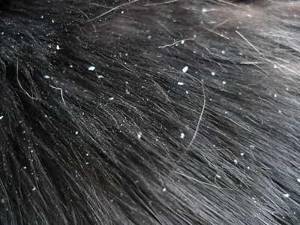
To treat dandruff in a cat, when dandruff appears, it is necessary to review the animal’s diet. If your pet’s fur is also coming out, then the menu may be lacking essential vitamins and nutrients.
Vitamin A, which is responsible for the condition of the skin and hair, is of great importance for the health of cats.
Experts also recommend regular intake of fatty acids necessary for the healthy development of your furry pet. It is not advisable to feed cats and kittens with dry food that contains a large amount of artificial additives. Natural food is the key to animal health.
If your cat's hair falls out a lot due to dandruff, then you should pay close attention to your pet's water treatments. For hygiene, you can only use high-quality approved products approved by a veterinarian.
Can cats have dandruff?
Many people are surprised when they hear that cats have dandruff. But if we think based on physiology, then this is a completely common, although not frequent, phenomenon. The processes of skin renewal are constant, and old skin flakes need somewhere to go and they get stuck in the cat’s thick coat. The layer of particles on the wool can be dry or oily. The root cause of the sebaceous layer is often seborrhea.
If the dead horny layer looks like crumbled flour or even snow, then they talk about the dry variety, and with the oily type, the hairs at the base look stuck together and greasy. The type of disease depends on the individual characteristics of each pet’s body.
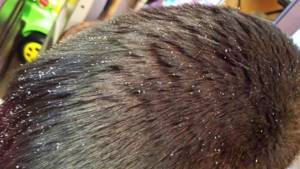
For some owners, this can be dangerous due to an allergy to cat dander, since a lot of cat saliva remains in the matted fur.
Type of dandruff
If you notice dandruff on your cat's back, you need to take a closer look at it. It may vary depending on the characteristics of a particular organism. Depending on its type, it can be oily or dry. Dry is manifested by the slightest scales, scattered throughout the animal’s fur. Oily dandruff is divided into liquid and thick. Liquid seborrhea - scales that stick together, are heavy and appear moist - most often appears on the ridge, near the tail or behind the ears. Thick seborrhea is practically invisible on the fur. The owner can see it by scratching the pet. In this case, skin particles will remain under the nails.
The amount of dandruff can also be different: it can be several “snowflakes” located in certain places, or a huge number of them scattered throughout the animal’s skin. If dandruff covers only some areas of the skin (for example, a cat has dandruff on its back), it is said to be a localized lesion; if it spreads over the entire surface - it is generalized.
If your pet has black dandruff, it means he has fungus or parasites. Regular dandruff cannot be black.
Causes of dandruff in cats
There are external and internal reasons for the appearance of particles of dead skin in an animal's fur, which explain why the skin looks untidy.
fungal skin diseases inhibit healthy cells and contribute to their death and exfoliation;
skin parasites such as fleas, ticks, lice eaters. With their vital activity, they cause itching in the cat and, as a result, scratching from the claws exfoliates skin particles even more;
diseases associated with the gastrointestinal tract and others;
diseases of the genitourinary system;
disturbances at the hormonal level;
disorders of the thyroid gland;
allergic reaction of cats to food or environmental factors;
stress, fear, fears;
reaction to certain medications. There are products that promote excessive dry skin. Shampoos that are not suitable for cats can have the same effect;
dietary errors and lack of fatty acids in the diet;
excess weight does not allow the pet to fully care for its fur coat in the back and tail area, so dandruff is often noticeable there.
External causes of dandruff include improper care of the pet: lovers of cat baths may one day be surprised to notice that “snow” is falling from the cat’s fur, or, on the contrary, sticky, unkempt fur has appeared behind the ears and on the back. If you are allergic to the shampoo, this will also be clear from the crumbling skin particles.
Dry air will affect the condition of the coat. If your home is excessively dry, this will soon affect your pet's skin. Sunburn will also make itself felt. No matter how old the animal is, dandruff can easily occur in both an old cat and a tiny kitten.
Treating a cat for dandruff
To rid your pet of bran, you need to determine the reason that caused the increased exfoliation of dead skin particles. A small kitten can be very depressed by itching, so the investigation should not be delayed. You will probably have to deal with this for quite a long time: for example, if the cause is dry air in the apartment, then the problem requires a global solution.
Before going to a specialist with a question about how to treat dandruff in a cat , you can independently eliminate the cause of the phenomenon. Negative factors such as improper diet, inappropriate shampoo, and dry air can be easily corrected by owners without the intervention of a veterinarian, and additional drug treatment for back dandruff is not required.
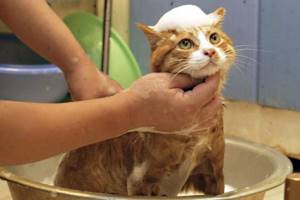
It's worth asking yourself if your cat had something new in her diet after which dandruff was noticed. You can cure the attack by simply excluding the product from the menu.
If shortly before the “snowfall” the pet was given some kind of medicine from skin particles, this must be mentioned to the veterinarian during the examination. The doctor is even informed about procedures such as grooming performed in the salon and the latest treatment for parasites.
If it was not possible to eliminate the disease, then you should not try to become a veterinarian at home without special education: the doctor is much better able to detect a disorder in the cat’s body and prescribe appropriate effective treatment.
Anti-dandruff shampoo for cats
The first thing you should try after adjusting your diet is anti-dandruff shampoo. Such products function as antifungal, antibacterial and normalize the functioning of the sebaceous glands. The main active ingredients are zinc and salicylic acid. Thanks to their effect, the upper layer of skin is regenerated and wounds heal.
The most famous shampoo can be called a product called “Doctor” from TD Goodman. The advantages of the drug include the elimination of unpleasant odor, itching and allergic reactions. The shampoo is easy to foam and rinse off without leaving any residue, leaving the coat looking silky and shiny. If you want to get rid of skin flakes at once, then you should not hope for this - a noticeable effect is achieved in several applications over a long time.
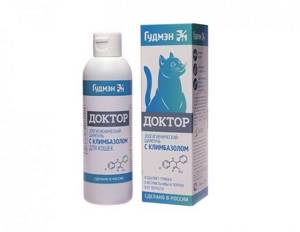
Apply the shampoo to the coat and do not rinse off for 3-5 minutes. At this time, you should distract your pet and not let her try to lick the product.
It would be good if you consult a specialist before using the drug described above.
Professional-level shampoo from Anju Beauté is called super-cleansing. Its action is aimed at normalizing the functioning of the sebaceous glands, as a result the skin is degreased, the secretion of the sebaceous glands is reduced, and the coat itself is moisturized.

The composition contains nettle extract - the cat's coat will grow faster and look much neater and more beautiful.
The product is very economical - for washing it is used in a ratio of 1 to 5 with water.
Vitamins for cats against dandruff
In case of seborrheic revelry on the skin, a vitamin course will not be superfluous:
Cat Felltop Gel with biotin and zinc is great for skin problems;
Cat – Fell OK (Canina) – vitamin and mineral complex with an unlimited course of administration;
Laveta Super for Cats (Beaphar) - thanks to vitamins B, E, biotin and taurine, the coat will become healthy and shiny.
Derm Caps and Derm Liquid is an effective vitamin complex from German developers and is aimed at restoring the skin and improving the health of the coat;
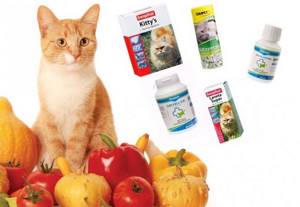
Even the best vitamin complexes will not be able to help if the true cause of dandruff is not eliminated.
Anti-dandruff spray for cats
To treat dandruff in cats, you can use medicated sprays like Tropiclean Oxy-Med. This is a natural remedy with colloidal oatmeal, wheat germ proteins, vitamins B5 and E, and salicylic acid. All substances actively act on the affected area, healing both the skin and coat. Swelling is noticeably reduced and itching is eliminated, and the activity of the sebaceous glands is regulated.
Parasites
Often, owners of pets with black fur, having discovered dandruff on the back of a cat of the corresponding color, consider this phenomenon to be the norm. However, dark scales are more likely the result of infection by parasites and fungi that irritate the skin with waste products. Almost imperceptible exfoliation of particles of light, transparent or grayish, yellowish colors is considered normal.
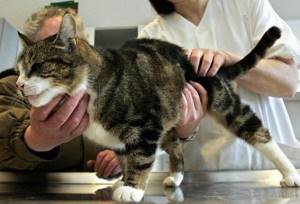
Complications
Fatty particles of dead epithelium are noticeable in the highly shiny coat. And if you don’t look for the reason, the animal’s appearance will be neglected and unkempt. This disease signals problems in the body: leukemia virus, systemic lupus erythematosus, chronic liver disease, drug rash.
An untreated disease also leads to hair loss.
Seborrhea, as a cause of skin peeling, can easily be transmitted from one cat to another, which will also not make owners happy. Therefore, there is no place for thinking here - treat and treat again.
Black dandruff in cats
If the dandruff suddenly turns out to be black, and the color of the animal is also black, you should not calm down, this is not the norm. Particles of peeling skin can be light gray, cream, white, but if they are black, then there is a fungal disease or the presence of parasites in the body.
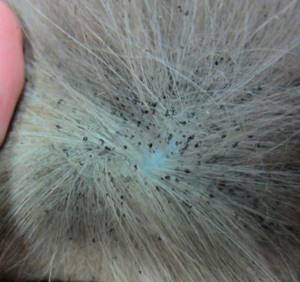
The cat has dandruff and hair loss
Yesterday my cat was diagnosed with dandruff, and today we noticed that she was shedding a lot of hair - yes, this happens. A cat with dandruff sheds much more, and can even get bald spots from actively trying to scratch its itchy skin.
The veterinarian will give a conclusion whether the cause is parasites, fungus or poor nutrition. In the first two cases, adequate medications will be prescribed, and nutrition will need to be adjusted at home. If the cat ate dry food, then you will have to choose a different type of food for it.
Stray dandruff in a cat
In addition to the usual dandruff, cats also have so-called wandering dandruff, which is caused by the Cheyletiella mite. The disease itself is called cheyletiellosis. The disease, unlike the word, is completely unsightly and extremely contagious for all pets with fur. The mite calmly moves in the keratin layer of the skin, so the dandruff itself, which covers the fur in a thick layer, also moves after the mite. Cheyletiellosis in cats is not difficult to identify: the tick itself can be seen with a good magnifying glass, and the fur looks like a battlefield: there are tracks on the skin everywhere along with a thick rash of skin scales.
Treatment of cheyletiellosis begins with cleaning with a vacuum cleaner, or better yet, with a steam generator, all the nooks and crannies of the home, with washing all bedding, rugs, and carriers. Then the cat begins to be bathed daily using sulfur-based preparations and even includes standard insecticides in the treatment.
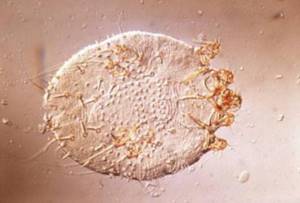
Long-haired sufferers are recommended to have their hair cut for a speedy recovery.
Symptoms
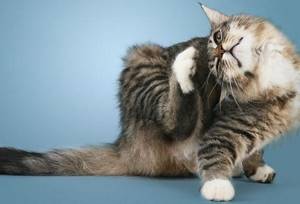
Symptoms of seborrhea in cats include:
1. The presence of peeling, widespread or localized.
2. Increased nervousness of the animal.
3. Expressed desire to scratch.
If you find dandruff on your cat's back, you should first rule out other diseases characterized by similar symptoms. This could be infection by parasites or fungi, allergies and other dermatological pathologies.
Prevention of dandruff in cats
Although the phrase “it is easier to prevent a disease than to treat it” set everyone’s teeth on edge, it remained and will always remain the most faithful advice. The first thing you should do not only for your pet, but also for your own health is to think about the optimal level of air humidity in the apartment. Along with maintaining the humidity level, do not forget about the animal’s constant access to clean, fresh water.
To prevent the formation of creepy-looking, untidy tangles on the fur, clogged with particles of dead skin, the cat is washed with high-quality shampoo in warm, not hot water.
Of course, the presence of parasites in the cat’s life, both inside the body and on the fur, is unacceptable.
For those owners whose cats have access to walking, the advice will be relevant to avoid allowing your pet to stay in the sun for long periods of time.
It remains to add a recommendation for proper nutrition of the purr and the care of the owner, preventing possible stress.



